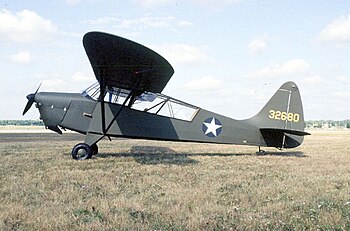Interstate L-6
| Interstate L-6 | ||
|---|---|---|
| description | ||
| Type of use | Observation and liaison aircraft | |
| Armament | no | |
| crew | A pilot and an observer | |
| Dimensions | ||
| length | 7.15 m | |
| span | 10.82 m | |
| height | 2.13 m | |
| Wing area | 16.15 m² | |
| Weights | ||
| Empty weight | 500 kg | |
| Maximum weight | 748 kg | |
| Motorization | ||
| Engine designation | Franklin O-200-5 | |
| power | 102 hp (start) | |
| Flight performance | ||
| Top speed | 183 km / h (at 5,500 feet) | |
| Use radius | 869 km | |
| Service ceiling | 5,030 m | |
The Interstate L-6 (until 1942: O-63 ) was a light liaison and reconnaissance aircraft used by the US Army from 1940 to 1945.
The Interstate Company began manufacturing aircraft in 1940 with the S-1B Cadet , a light high-wing tandem seater version. When the USA entered the war at the end of 1941, the US Army ordered 250 S-1B aircraft and designated the military version as the O-63 . It was the last pattern before 1962 that received the letter O for "observation". Like all other O-planes, the O-63 was renamed in 1942, in this case the L-6 . The engine of the L-6 suffered from an overheating problem that could never be completely solved, so the L-6 produced fewer units than the other light liaison aircraft known as "Grasshopper". The L-6 was used exclusively in the USA as a courier aircraft, liaison aircraft and for training and did not come to war in Europe or Asia.
After the war ended, the production rights for the Cadet were sold to Harlow Aircraft .
production
Acceptance of Interstate L-6 by the USAAF:
| version | 1942 | 1943 | TOTAL |
|---|---|---|---|
| L-6 | 11 | 240 | 251 |
| L-8 | 8th | 8th | |
| TOTAL | 19th | 240 | 259 |
See also
Web links
Individual evidence
- ↑ Statistical Digest of the USAF 1946, p. 100 ff.
